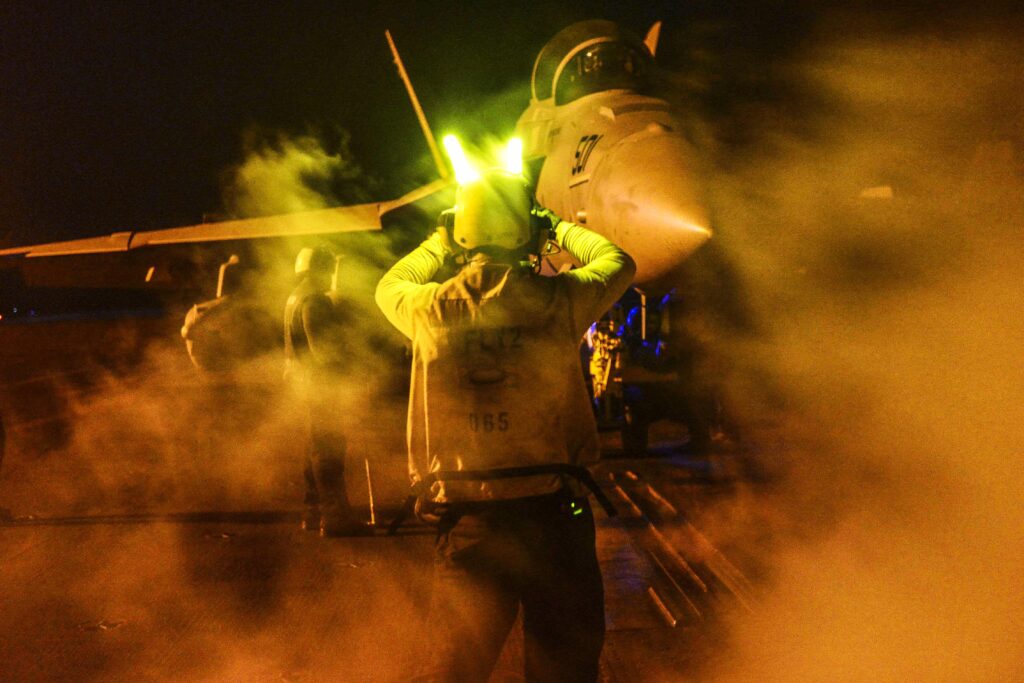How To Stop Islamic State’s Escalation Dominance
Posted on
While President Barack Obama’s declared both that the U.S. is hitting the Islamic State of Iraq and Syria “harder than ever” and that progress in the campaign to degrade and defeat the group “needs to keep coming faster,” he revealed clearly that the administration is in a race against time. American officials believed that their anti-ISIL strategy and military campaign of the last year-and-a-half had achieved a stalemate: The momentum of the ISIL juggernaut that captured large swaths of Syria and Iraq was largely checked, but U.S.-backed proxies have struggled to roll back the terrorist group’s vast territorial gains.
In fact, ISIL (which we’ll refer to as Daesh from now on) has, in fact, recaptured “escalation dominance” outside of Syria with a series of deadly terrorist attacks in Egypt, Lebanon, France, and the United States, even as its reach and influence continues to grow through increased pledges of allegiance from far-flung extremist groups. Meanwhile, the Syrian civil war that fuels its rise has produced the largest refugee crisis in Europe since World War II; shifted the political dynamic in Western countries far to the right, with unpredictable long-term implications; and provoked open fighting between a NATO ally and Moscow when Turkey downed a Russian warplane.
That steep escalation curve has prompted some of the leading experts in the country to implore the Obama Administration to adjust its strategy and contemplate more aggressive measures against Daesh, ranging from enforcing no-fly zones and safe sanctuaries inside Syria, to reintroducing U.S. ground forces to break Daesh’s hold on major population centers. Each of those options carries great risk. But so does the current trajectory towards a regional meltdown coupled with expanding terrorist attacks that are drawing major powers into the Syrian vortex.
“The Middle East is in the worst shape it’s been in a century, with a series of conflicts that are unprecedented in modern Arab history,” said Ryan Crocker, a preeminent Middle East expert and the former U.S. ambassador to Iraq during the 2007 U.S. “troop surge” that pulled the country back from the brink of civil war. The roots of the current crisis are similar to that earlier conflict: historical animosities between Sunni and Shiite Muslims that the terrorists of Sunni Daesh –and its predecessor Al Qaeda in Iraq — were determined to stoke into a regional conflict so that a fundamentalist Sunni caliphate could rise from the ashes. Seizing its opportunity in the Syrian civil war, Daesh has largely achieved that long-sought goal of Islamist extremists.
Given the apocalyptic, “end of days” slant to its medieval, Salafist ideology of a war between Islam and “non-believers,” the group is trying to provoke major powers to join the fray through terror attacks and calls for Western recruits to strike at home.
“The only way to defeat a group like ISIS and its caliphate is to take away its territory, but there is no regional ground force able to do that even with US airpower,” said Crocker. He would significantly increase the intensity of the US air campaign and establish no-fly zones and safe havens for Syrians in the north and south alongside Turkish and Jordanian allies. That would signal to Sunni Arabs that the Western powers are concerned about their welfare, drain support from Daesh and push back against [Syrian dictator Bashar] al-Assad and his Russian allies. “The alternative is to follow the same strategy we’ve pursued for the last 16 months,” said Crocker. “In that case we should expect the same results.”
Former CIA Director and Central Command leader David Petraeus agrees. “Syria today is a geopolitical Chernobyl, spewing instability and extremism over the region and the rest of the world,” Petraeus said in Congressional testimony in September. “Like a nuclear disaster, the fallout from the meltdown of Syria threatens to be with us for decades, and the longer it is permitted to continue, the more severe the damage will be.”

David Petreaus
All About Territory
But Crocker and Petraeus oppose reintroducing major U.S. ground combat units to the Middle East to expel Daesh. They both know from bitter experience in Iraq and Afghanistan how the presence of large scale US ground forces can play into the extremist narrative of “Christian crusader” forces stealing Muslim lands. A whole generation of U.S. military and diplomatic officials also learned firsthand how difficult it is for US military forces to extricate themselves from unstable conflict zones once they are introduced.
War teaches many lessons, however, and after a decade of fighting and going to school on Islamist extremists, US counterterrorism officials also understand that as long as ISIS holds territory and owns the narrative of an Islamic caliphate at war with “non-believers,” its strength and allure will continue to grow in the pantheon of global jihadists. That was true of Osama bin Laden and Al Qaeda in the sanctuary of Afghanistan in the 1990s, and it’s true of ISIS today.
The power of territory in the narrative of Islamist extremists can be traced to their fundamentalist religious ideology. In declaring himself the leader of the caliphate in a sermon in Mosul in July of 2014, for instance, Daesh leader Abu Bakr al-Baghdadi spoke at length about the importance of reviving an Islamic homeland that has not existed since well before the Ottoman Empire, and of the obligation of Muslims worldwide to defend it. “This is a duty upon the Muslims – a duty that has been lost for centuries,” said al-Baghdadi. “The Muslims sin by losing it, and they must always seek to establish it.”
Roughly 30,000 foreign fighters from 80 countries have heeded that call to defend the caliphate, doubling in number in the past year, and providing ISIS with a steady stream of recruits to replace those lost in battle. Each new terrorist “spectacular” like the downing of a Russian airliner or the massacre in Paris helps create more recruits. That’s a major reason why FBI Director James Comey recently stated that the United States currently faces its greatest terrorist threat since 9/11.
“ISIS has delivered what Osama bin Laden and Al Qaeda only promised, which is to redraw the borders Western powers established at the end of World War I in breaking up the Ottoman Empire,” said Bruce Hoffman, a counterterrorism expert and director of the Center for Security Studies at Georgetown University. “And whereas six months ago the group was considered primarily a local threat, we’re now seeing its branches spreading and more affiliates pledging allegiance in places like Libya, the Sinai and Afghanistan, and launching terror attacks in its name. So the current incremental strategy has not significantly undermined ISIS, which in many ways has adopted Al Qaeda’s expansionist strategy, only with even more ruthless execution.”
Recognizing that Daesh’s escalation threatens to outpace his incremental strategy of containment, President Obama dispatched Defense Secretary Ash Carter to the Middle East to secure more alliance contributions for the coalition fight. In general, however, the administration has decided to stick with a patient strategy that combines precision U.S. airstrikes and intelligence gathering with train-and-equip activities on the ground to empower various local proxies.
The risk for Obama and his successor is that Daesh continues to grow and gain strength, launching ever more deadly terrorist attacks. Already some experts believe that Washington is only one spectacular terrorist attack away from having to reconsider its aversion to U.S. “boots on the ground” in the fight against the Islamic State.

David Barno
“I don’t think the anti-IS campaign calls for U.S. ground troops at this point, but that could certainly change if we suffer another terrorist attack on a grand scale, and the U.S. military should certainly be thinking what a ground attack would look like if it received that order,” said retired Lt. Gen. Dave Barno, former senior commander of all U.S. and coalition forces in Afghanistan. Daesh is growing into a “proto-state,” he noted, amassing significant resources through various streams of taxation and extortion; implementing a judicial system based on the group’s fundamentalist interpretation of Islamist sharia law, which includes beheadings, amputations and sexual slavery; and growing in territory and influence through pledges of allegiance from other jihadist groups who now see its brand as the gold standard in terms of striking terror in the hearts of their enemies.
“The Islamic State is not contained, and this geographic expansion of its influence we’re seeing in places like Libya, Afghanistan, and the Sinai is extraordinarily dangerous,” said Barno. “The longer this proto-state exists, the more power it will accumulate. The only way to counter that is to take back territory it has captured.”

Gen. Anthony Zinni
A Real War Against Daesh
One expert who believes the United States is foolish to rule out U.S. combat forces taking territory from Daesh is Anthony Zinni, former leader of Central Command. The template he envisions is the 1991 Persian Gulf War in which the U.S. led a large coalition with significant Sunni Arab participation, and quickly handed off responsibility to hold and govern recaptured territory to Arab partners.
“President Obama and [French President Francois] Hollande have declared that we are at war with ISIS, and that the enemy must be defeated, but at the same time we’re taking the option of ground forces off the table, which is the only way to seize territory and defeat this enemy. That only makes the West look weak, and causes more disenfranchised youth to flock to the caliphate of a strong ISIS,” Zinni said in an interview. A Desert Storm paradigm of overwhelming force and a broad, inclusive coalition, he said, would limit casualties and quickly overwhelm Daesh defenders. “We’re only one ISIS atrocity away from having to confront the 800-pound gorilla in this debate, which is the need for U.S. ground forces to shape the anti-ISIS campaign.”
In terms of a campaign plan, Zinni envisions a NATO force led by two to four U.S. combat brigades attacking Daesh’s Syrian redoubts from the north out of Turkey; an Arab coalition backed by U.S. airpower and led by the Gulf Cooperation Council of Persian Gulf states attacking from the south out of Jordan; and an Iraqi army of Kurdish Peshmerga and Iraqi Security Forces backed by U.S. airpower attacking simultaneously from the east. “Such a coordinated campaign would crush ISIS in a matter of a few months, at most,” said Zinni.
Of course the most daunting aspect of coordinating such a campaign would be the diplomacy involved in getting all the players on a common page after so much bloodshed. Iran and the Assad regime would need to be persuaded to stay out of the fight against ISIS, which as Shiites they abhor. There would also need to be de-confliction with Russian forces inside Syria. Even more difficult, the effort would require a diplomatic mediation on the future of Syria the day after ISIS is expelled from territory there. The one advantage in that scenario is that ISIS has virtually no friends in the community of nation-states.
“The larger point is that the United States needs to be creative in trying to correct the mistakes the Western powers made in drawing the borders of the Middle East after World War I, and that requires thinking strategically. Almost no one in Washington does that anymore,” said Zinni. “Somehow we’ve gone from rash and stupid with the [George W.] Bush Administration, to weak and ineffective with the Obama Administration.”
Subscribe to our newsletter
Promotions, new products and sales. Directly to your inbox.



